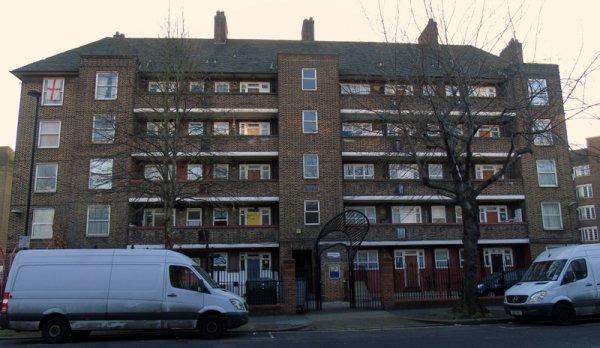Nov 10th 2022, 14:41
Blog - 10th November 2022
In this blog I consider what we can learn about social housing in England from the Regulator of Social Housing’s statistics for 2021/22 and the problems faced by unpaid carers.
The Regulator of Social Housing in England has published its latest statistical report that covers local authorities and housing associations in 2021/22.
There are currently 4.4million social homes in England, 2.8million of which are owned by housing associations and 1.6million by local authorities.

Council flats on the Briant estate in Lambeth.
Lack of social housing has been a problem for years and a major cause of the housing crisis. Council stock has been significantly reduced since the introduction of Right to Buy in 1980 and because of the stock transfer programme between 1988 and 2012; while housing association stock has increased because of new developments as well as stock transfers.
Each year over the past decade, councils have reported a net loss in the number of homes they own, while housing associations have reported a net gain. In 2021/22 there was a small increase of 0.7% in the overall number. However, This overall increase was driven by a 23,349 increase in affordable rent homes and a 18,168 increase in low-cost homeownership properties, but there was also a large drop of nearly 10,000 social rent homes, most of which were owned by councils.
The condition of social housing has gained national attention mainly as a result of ITV News’ long-running investigation that has highlighted several examples of poor standards. The official standard with which social landlords in England should comply is the Decent Homes Standard – that is generally considered to be not demanding enough and is currently under review. In 2020/21, 0.4% of housing association stock was non-decent compared with 8% of council stock. In 2021/22, the proportion of housing association stock that was non-decent reduced to 0.3% but the council data is not available.
Given the low rate of inflation during the pandemic, the limit on rent increases for 2021/22 was 1.5%. However, the average weekly social rent for general needs increased by 1.6%, slightly above the limit, presumably because there were higher rents in developments and relets.
The average weekly social rent was £94.31. London and the South East had the highest weekly net rents on average, both over £100 per week. The North East had the lowest average weekly net rent of £78.89.

Bramble Court in Brampton, Cumbria. An extra care elderly scheme developed by Impact Housing Association.
The average weekly supported housing net rent in England in 2021/22 was £91.49. London had the highest average weekly net rent of £108.29 that is nearly 30% higher than the average weekly rent in the East Midlands at £83.72. Rent for supported housing increased by 1.7% on average, though there was a significant variation by region with the highest increases in the northeast and the lowest in Yorkshire. Housing associations own 334,000 supported housing units while 102,000 are owned by councils.
The average affordable rent increased by 2.6% in 2021/22.
In September 2022 the annual increase in the consumer prices index was 9%, meaning that rents would increase by 10% in April 2023 if current government rent policies were to continue. However, the government is out to consultation on a proposal to cap rent increases at 3%, 5% or 7%. Most commentators originally expected the government to opt for the 5% cap, although more recently there have been suggestions that the government would not cap rents but would urge landlords to use their discretion to increase rents by less than the limit. If rents were to increase by 10% that would be unaffordable for many tenants, while if they were to increase by less than 10% landlords would be unable to absorb increases in prices and interest rates without making major savings.
To view the regulator's statistical reports, please click here.
This week Carers UK released their ‘State of Caring 2022’ report: the largest and most comprehensive survey of unpaid carers. This year, a record number of carers took part, with over 12,400 current carers helping them to paint a picture of caring in 2022.
It is clear from carers’ responses that the cost of living crisis has created unprecedented pressure for carers that has not only affected their finances but their health and wellbeing. Last month, Carers UK published a report ‘Heading for Crisis: caught between caring and rising costs’ based on these findings.
As well as finances, the State of Caring 2022 survey covered many other aspects of caring, from the impact of caring on health, to experiences of using support services, and the challenges of juggling work and care. The huge pressures placed across the NHS, together with the record levels of demand for social care services, means that many carers may not be getting the support they need.
The report found that:
While Governments across the UK have taken a range of actions to provide carers with help and support, much more must be done. Carers UK have set out several recommendations on how carers should be supported, from a funded National Carers Strategy for England to review and reform of carers’ benefits and investment in social care to support carers with adequate breaks. They have also been campaigning for a landmark new right for employed carers to take up to one week of unpaid Carer’s Leave. This is now included in the Carers’ Leave Bill put forward by Wendy Chamberlain MP (Liberal Democrat, Northeast Fife) that has secured government support and has now passed its Second Reading.
With increasing numbers of people in need of care and much of this care being provided by unpaid carers, the government needs to give more serious consideration to how it supports unpaid carers in their important role.
For further information please follow the links below: